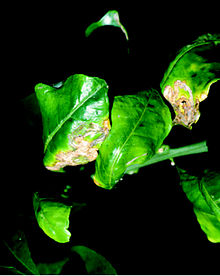| Citrus canker | |
|---|---|
 Lesions on leaves | |
| Common names | bacterial spot of citrus |
| Causal agents | Xanthomonas axonopodis pv. citri |
| Hosts | citrus trees, including lime, oranges and grapefruit |
| EPPO Code | XANTCI |
| Distribution | Brazil and the United States |
Citrus canker is a disease affecting Citrus species caused by the bacterium Xanthomonas (X.axonopodis; X. campestris). Infection causes lesions on the leaves, stems, and fruit of citrus trees, including lime, oranges, and grapefruit. While not harmful to humans, canker significantly affects the vitality of citrus trees, causing leaves and fruit to drop prematurely; a fruit infected with canker is safe to eat, but too unsightly to be sold. Citrus canker is mainly a leaf-spotting and rind-blemishing disease, but when conditions are highly favorable, it can cause defoliation, shoot dieback, and fruit drop.[1]
The disease, which is believed to have originated in Southeast Asia,[2] is extremely persistent when it becomes established in an area. Citrus groves have been destroyed in attempts to eradicate the disease.
Countries like Brazil and the United States also suffer from canker outbreaks.[3]
- ^ Timmer, L. W.; Garnsey, Stephen Michael; Graham, J. H., eds. (2000). Compendium of citrus diseases (2nd ed.). St. Paul, Minn. ISBN 978-0-89054-585-0. OCLC 754604839.
{{cite book}}: CS1 maint: location missing publisher (link) - ^ Dewdney, Megan M.; Burrow, Jamie D.; Graham, James H.; Spann, Timothy M; Atwood, Ryan A. (March 2016). "PP323 Dooryard Citrus Production: Asiatic Citrus Canker Disease" (PDF). Plant Pathology Department, UF/IFAS Extension. Retrieved 5 November 2022.
- ^ "Citrus canker". DAFF. Australian Government; Dept of Agriculture, Fisheries and Forest. 12 August 2021. Retrieved 5 November 2022.